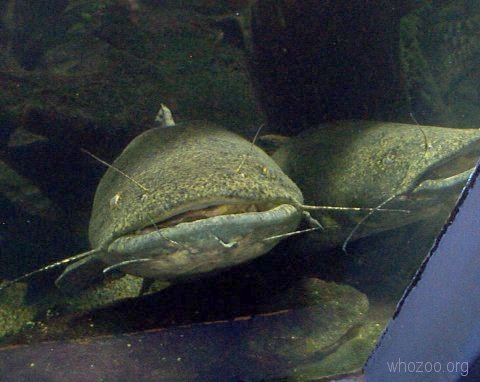 |
 |
| Name: Flathead Catfish |
| Scientific name: Pylodictis olivaris |
| Range: Rivers in the Mississippi, Missouri, and Ohio basins; as far north as North Dakota, as far west as New Mexico, and south to the Gulf including eastern Mexico; statewide in Texas, also found in limited areas of Florida |
| Habitat: Large rivers and tributaries |
| Status: Not threatened |
| Diet in the wild: Bass, bream, shad, crayfish, aquatic insects, and other catfish |
| Diet in the zoo: A special food called grind, and Kacklin fish |
| Location in the zoo: James R. Record Aquarium |
| General information: The flathead catfish has a huge range that encompasses numerous states in the United States and Mexico. Flatheads are native the entire state and of Texas are fished heavily in Texas as well as wherever they may dwell. Female flatheads can lay up to 100,000 eggs and these eggs are guarded by one adult male. The adult male guards these eggs with his life and will fight to protect them. Adult males are usually "loners" that prefer the deeper waters or the cover of a log, rock, or shade from a tree. The world record for the biggest flathead catfish caught is 91.25 pounds, caught in Lake Lewisville, Texas. Flatheads have been observed and aged up to 19 years old, but it is likely that they live much longer than 19 years. |
| Special anatomical, physiological or behavioral adaptations: Flatheads are extremely strong fish and put up a fight for fishermen. Flatheads are hard to fish due to their extreme solitary habits, night time is considered the best time to catch them. It may be concluded that since most adult flatheads are solitary they really do not care about other flatheads, so they resort to cannibalism and eat their own on occasion. Since they are predators and consume other fish it is no surprise that they can get very large and heavy. "The barbels contain taste organs and thus in a sense are an extension of the tongue. This is logical since the majority of catfishes are active at dusk and at night and need a supplementary organ to detect food" (Grzimek 363). |
| Personal observations: The flatheads at the Fort Worth Zoo are rather large and you can see their huge whiskers. They always seem to look angry and bump into the glass of their aquarium. You can see quite a ways down their huge mouths and it is obvious that they are heavy eaters. They probably are angry because they can not be in solitude like they prefer in their natural habitat. |
| Source Materials and Related Links:
Texas
Parks and Wildlife: Entry on Flathead Catfish The New Encyclopaedia Britannica. Vol. 2, Bayeu-Ceanothus.
Encyclopaedia Britannica, Inc., Chicago. 1987. Page 950
|
| Author: Jason Paul Flores
Email: jflores@bmsmanagement.com |